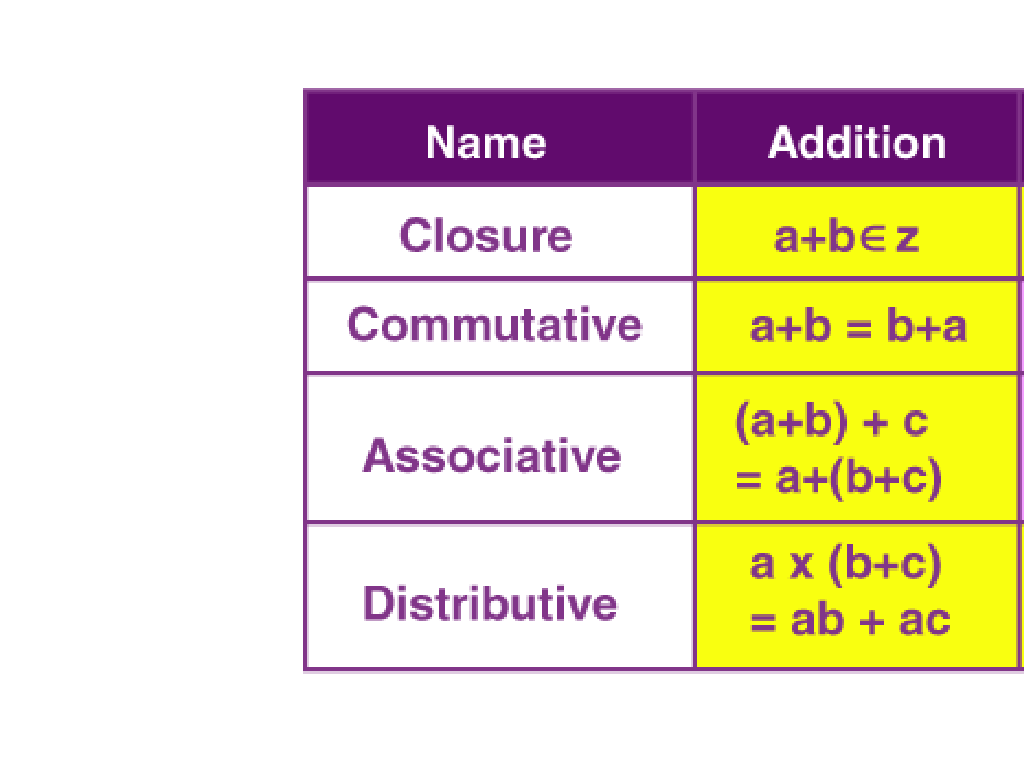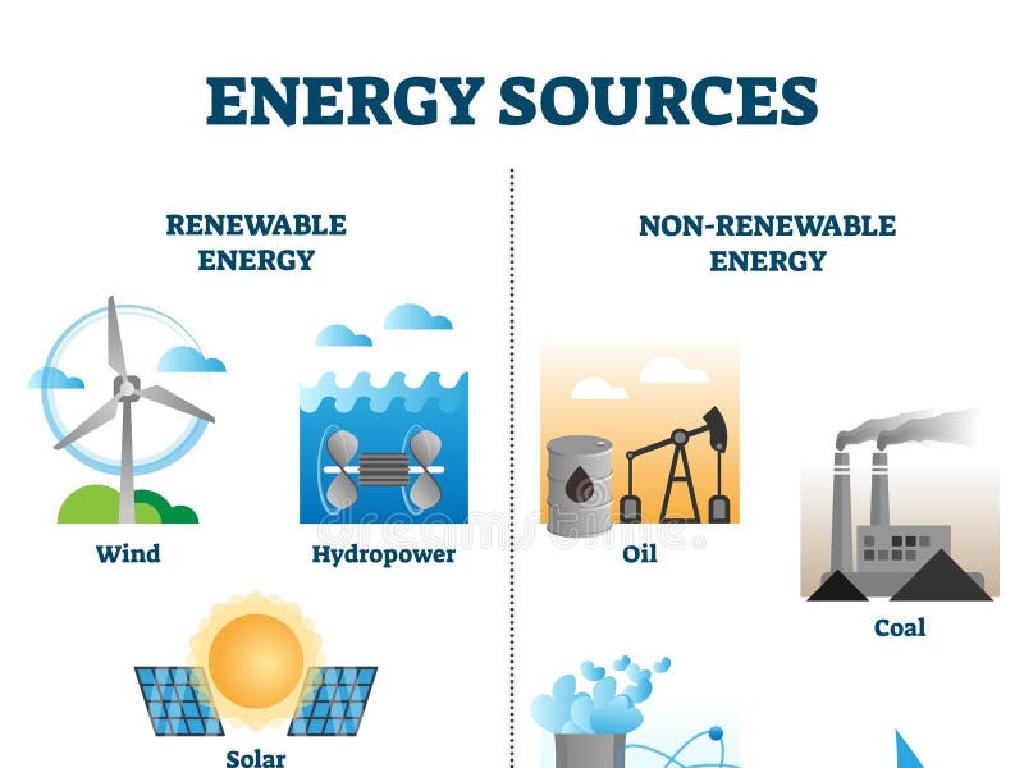How Do Flowering Plants Make New Plants?
Subject: Science
Grade: Third grade
Topic: Plants
Please LOG IN to download the presentation. Access is available to registered users only.
View More Content
The Magic of Flowering Plants
– Importance of flowering plants
– They give us oxygen, food, and beauty.
– How plants fit in our ecosystem
– Plants provide habitats and food for animals.
– Flowering plants reproduction
– They use flowers to attract pollinators and create seeds.
– The journey from flower to new plant
– Seeds grow into new plants, continuing the life cycle.
|
This slide introduces students to the significance of flowering plants in our ecosystem and their reproductive process. Begin by discussing the various ways flowering plants benefit our environment, including oxygen production, food sources, and aesthetic value. Explain the ecosystem’s interdependence, highlighting the role of plants in providing habitats and sustenance for wildlife. Dive into the reproduction of flowering plants, emphasizing the function of flowers in attracting pollinators like bees and butterflies, which help in the pollination process. Conclude by explaining how seeds formed after pollination can grow into new plants, ensuring the continuation of the species. Encourage students to observe flowering plants in their surroundings and consider the importance of each stage in the plant’s life cycle.
What Are Flowering Plants?
– Flowering plants are everywhere
– They have parts for plant-making
– Like seeds, stems, roots, and flowers
– Learning about these special parts
– How these parts help make new plants
– Flowers help with reproduction
|
This slide introduces the concept of flowering plants and their role in plant reproduction. Flowering plants are a common sight in many environments and are essential to the ecosystem. They possess unique parts such as seeds, stems, roots, and flowers, each playing a specific role in the plant’s life cycle. Today’s lesson will focus on understanding these parts, particularly the flowers, which are crucial for reproduction. Students will learn how flowers contribute to the creation of new plants, ensuring the continuation of the plant species. Engage the students by asking if they have seen any flowering plants recently and what parts they can identify.
Parts of a Flowering Plant
– Roots anchor and nourish
– Roots hold the plant in soil and take in water and nutrients
– Stem supports and transports
– The stem holds up the plant and moves water and nutrients between roots and leaves
– Leaves make food via photosynthesis
– Leaves use sunlight to make food for the plant, a process called photosynthesis
– Flowers are for reproduction
– Flowers can make seeds that grow into new plants
|
This slide introduces the main parts of a flowering plant and their roles in the plant’s growth and reproduction. Emphasize that each part of the plant has a unique and important function. Roots not only anchor the plant in the soil but also absorb water and nutrients essential for growth. The stem acts as a support system and a transport network for water, nutrients, and food. Leaves are the site of photosynthesis, where the plant converts sunlight into energy. Lastly, flowers are crucial for reproduction; they contain the organs necessary for the plant to produce seeds. These seeds can then grow into new plants, continuing the life cycle. Encourage students to think of examples of each part of the plant and how they work together to help the plant survive and reproduce.
How Do Flowers Make Seeds?
– Flowers create seeds via pollination
– Pollination is when pollen grains move from the male part of the flower to the female part.
– Pollination occurs through wind, water, animals
– Each method helps pollen travel to fertilize flowers in different environments.
– Bees: vital pollinators for many flowers
– Bees collect nectar and pollen, transferring pollen between flowers.
– Understanding the role of pollinators
|
This slide introduces the concept of pollination as the process by which flowers produce seeds. It’s important to explain that pollination is necessary for the reproduction of flowering plants and can occur through various means such as wind, water, and animals, with bees being a key example. Emphasize the symbiotic relationship between bees and flowers; bees get food, and flowers get to reproduce. Discuss the different ways pollination helps plants survive in diverse habitats. Encourage students to think about how the absence of bees might affect the environment and food supply.
The Life Cycle of a Flowering Plant
– Life cycle begins with a seed
– A tiny seed can grow into a beautiful flower!
– Pollination leads to seed formation
– Bees and butterflies help flowers by spreading pollen.
– Seeds develop into new plants
– With soil, water, and sun, seeds sprout and grow.
– Cycle repeats with new seeds
|
This slide introduces the concept of the life cycle of a flowering plant, which is a continuous loop starting and ending with the seed. Emphasize the importance of each stage in the cycle. Explain pollination as a process where bees, butterflies, and other creatures help move pollen from one flower to another, leading to the creation of seeds. Discuss how seeds need the right environment to grow into new plants, including soil, water, and sunlight. Encourage students to think about how this cycle is nature’s way of ensuring that plants continue to grow year after year.
Let’s See It in Action: Plant Growth
– Watch a plant grow from seed
– Time-lapse video shows each stage quickly
– Observe the flowering process
– Look for the bloom – that’s the flower opening!
– See how seeds are produced
– New seeds form after flowers bloom
|
This slide is designed to visually demonstrate the life cycle of a flowering plant. The time-lapse video will show the entire process from a seed sprouting, growing into a mature plant, developing flowers, and eventually producing new seeds. Encourage students to pay close attention to the changes at each stage, especially the development of flowers, which is crucial for reproduction in flowering plants. After watching, discuss the stages and ask students to describe what they saw in their own words. This will help solidify their understanding of the plant life cycle and the role of flowers in plant reproduction.
Fun Facts About Flowering Plants
– Over 300,000 flowering species
– That’s more than all mammal, bird, and reptile species combined!
– Some flowers bloom at night
– Like the moonflower, which opens when the sun sets
– World’s largest flower facts
– The Rafflesia arnoldii can grow up to 3 feet in diameter
|
This slide aims to spark interest in the diversity and uniqueness of flowering plants. Highlight the vast number of species, which surpasses the combined total of mammals, birds, and reptiles, to give students a sense of the richness of plant life. Discuss nocturnal flowers, like the moonflower, to illustrate the variety of plant behaviors. Introduce the Rafflesia arnoldii as an example of extreme plant sizes, which can be as large as a small child! These facts can lead to discussions on plant adaptation and biodiversity. Encourage students to think about the different plants they know and how they might fit into these fun facts.
Class Activity: Planting Our Seeds
– Time to grow your own plant!
– Plant seeds in pots carefully
– Water them and place in sunlight
– Just enough water to keep soil moist, not too wet
– Observe changes over time
– Keep a plant diary with drawings and notes
|
This activity is designed to give students hands-on experience with plant growth. Each student will plant their own seeds in pots provided by the teacher. It’s important to demonstrate how to plant the seeds properly and cover them with soil. Explain the necessity of water and sunlight for plant growth. Students should water their plants regularly, ensuring the soil is moist but not overly wet to prevent root rot. Place the pots in a sunny area of the classroom. Encourage students to observe their plants every day and record growth changes in a ‘plant diary’, which can include drawings, measurements, and observations. This will help them understand the process of germination and the factors that affect plant growth. Possible variations of the activity could include using different types of seeds, comparing growth in different conditions, or measuring the growth rate.






